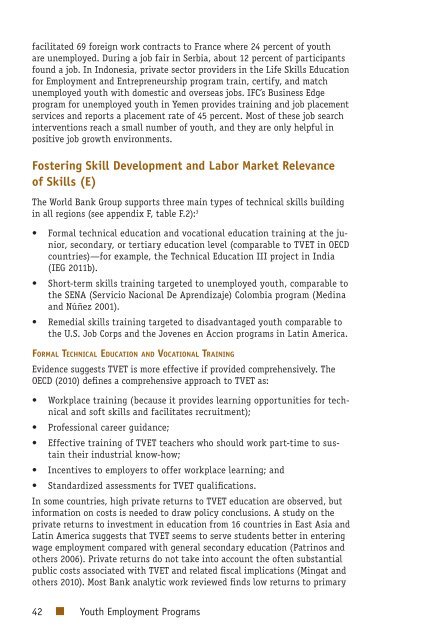Youth Employment Programs - Independent Evaluation Group
Youth Employment Programs - Independent Evaluation Group
Youth Employment Programs - Independent Evaluation Group
Create successful ePaper yourself
Turn your PDF publications into a flip-book with our unique Google optimized e-Paper software.
facilitated 69 foreign work contracts to France where 24 percent of youthare unemployed. During a job fair in Serbia, about 12 percent of participantsfound a job. In Indonesia, private sector providers in the Life Skills Educationfor <strong>Employment</strong> and Entrepreneurship program train, certify, and matchunemployed youth with domestic and overseas jobs. IFC’s Business Edgeprogram for unemployed youth in Yemen provides training and job placementservices and reports a placement rate of 45 percent. Most of these job searchinterventions reach a small number of youth, and they are only helpful inpositive job growth environments.Fostering Skill Development and Labor Market Relevanceof Skills (E)The World Bank <strong>Group</strong> supports three main types of technical skills buildingin all regions (see appendix F, table F.2): 3• Formal technical education and vocational education training at the junior,secondary, or tertiary education level (comparable to TVET in OECDcountries)—for example, the Technical Education III project in India(IEG 2011b).• Short-term skills training targeted to unemployed youth, comparable tothe SENA (Servicio Nacional De Aprendizaje) Colombia program (Medinaand Núñez 2001).• Remedial skills training targeted to disadvantaged youth comparable tothe U.S. Job Corps and the Jovenes en Accion programs in Latin America.Formal Technical Education and Vocational TrainingEvidence suggests TVET is more effective if provided comprehensively. TheOECD (2010) defines a comprehensive approach to TVET as:• Workplace training (because it provides learning opportunities for technicaland soft skills and facilitates recruitment);• Professional career guidance;• Effective training of TVET teachers who should work part-time to sustaintheir industrial know-how;• Incentives to employers to offer workplace learning; and• Standardized assessments for TVET qualifications.In some countries, high private returns to TVET education are observed, butinformation on costs is needed to draw policy conclusions. A study on theprivate returns to investment in education from 16 countries in East Asia andLatin America suggests that TVET seems to serve students better in enteringwage employment compared with general secondary education (Patrinos andothers 2006). Private returns do not take into account the often substantialpublic costs associated with TVET and related fiscal implications (Mingat andothers 2010). Most Bank analytic work reviewed finds low returns to primary42 <strong>Youth</strong> <strong>Employment</strong> <strong>Programs</strong>
















